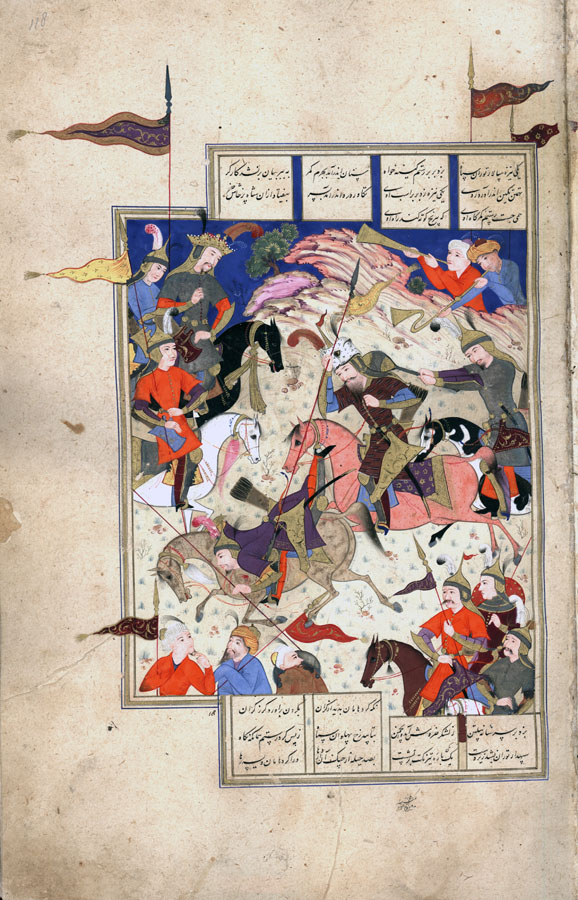Rostam Fights Afrāsiyāb, Humān and the Turānians
The painting depicts the decisive battle in Turān where the forces of Afrāsiyāb are defeated. Rostam is portrayed in his usual attire near the center of the composition, astride his faithful steed Raḵš. The Turānian warrior to the left has attempted to vanquish Rostam with his lance but was unsuccessful. Rostam, leaning forward in the saddle, grasps the lance, and rams it into the side of the Turānian’s horse; the sheer force of the thrust has caused the horse to go down on its knees, throwing its rider headlong from the saddle. Meanwhile, on the extreme right, another Turānian on a black and white horse, who can be identified as Humān, has with all his force struck the Iranian hero from behind with a bulbous mace. But it has been of no avail, for Rostam does not flinch. In the upper left, the Turānian king Afrāsiyāb accompanied by two mounted soldiers carrying standards, sits observing the battle on a black horse, but without taking any active role. Three other mounted soldiers, possibly Iranian, observe from the right foreground, but do not participate in the fighting. In the lower left, are three bearded men with turbans; two have their hands withdrawn inside their sleeves, the ends of which flap loosely. This suggests they are darvishes, yet they are holding standards. Leaning over the crest of the hill in the upper right are two turbanned trumpeters, with long horns, sounding the call. The setting is a barren, sloping hillside, with tufts of grass evenly dispersed, that rises to a rocky crest. Bushes grow along the crest. The long lances whose linear movements cut diagonally across the miniature are a strong design element that strengthens the ambience of action being portrayed.
There are four columns of text above and below the painting. At the top, two columns are comprised of three lines each, and the remaining columns of two lines. The bottom columns have the same number of lines, but juxtaposed with the top, so that overall each column has an equal number of lines. A rectangular frame encloses painting and text. The painting is extended on the left side, and the frame juts out to encompass it. Five standards protrude into the margins. The painting is signed in the lower margin in miniscule characters in Moʿin’s hand: raqam zad kamina moʿin-e moṣavver. The inscription is not dated.
Painting references:
Welch, AK4_1978, p.90, Ms.22, folio 118r (not ill.).
Text references:
Warner, II, pp.353-55; Mohl, II, pp.367-68; Levy, pp.102-3.
Robert Eng
Last Updated: June 29, 2011 | Originally published: June 29, 2011
